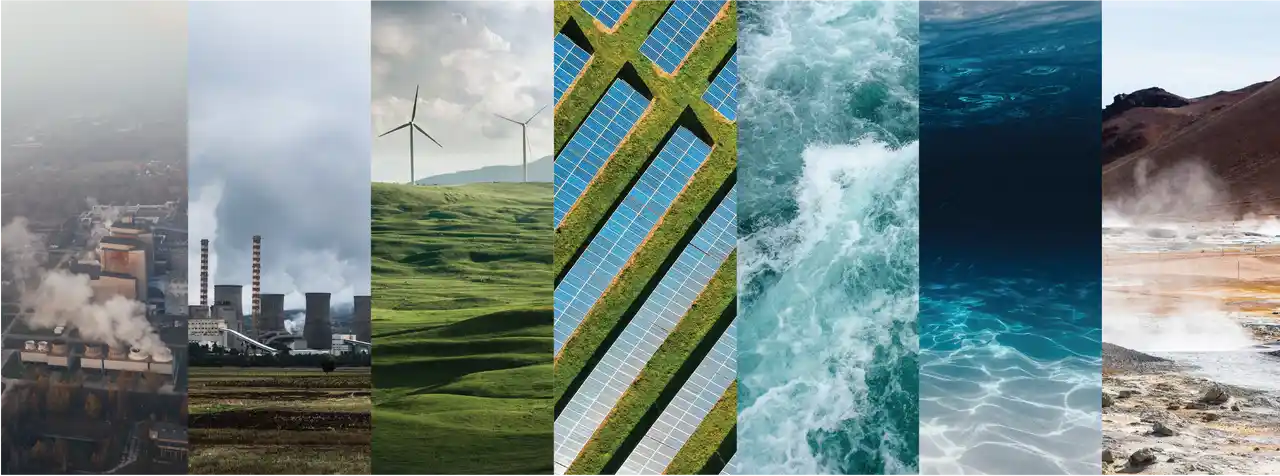
Like it or not, we are going to need nuclear energy to fight climate change. EnPowered simplifies energy management.
TL;DR
-
Forgoing nuclear power, which provides carbon-free baseline generation, will make fighting climate change harder and more expensive.
-
Cheap natural gas, cost overruns, and public opinion all hinder further nuclear power development, especially in Europe and North America.
-
Condemning fossil fuels while also opposing nuclear power and hydropower mega projects leaves developing nations with no viable alternatives to quickly decarbonize.
From post-war mania about the dawn of a new atomic civilization, to post-Chernobyl and Fukushima ostracization, nuclear energy has undergone a public relations rollercoaster. For decades, nuclear energy has been panned by environmental organizations, but the greater focus among environmentalists on reducing greenhouse gas (GHG) emissions over the past 20 years has left the question of nuclear energy unresolved.
Existing concerns about nuclear waste, radioactivity, and meltdowns now coincide with an (for some) uncomfortable truth: nuclear energy is the best option we currently have for massive increases in zero-carbon baseline generation.
Over the past 50 years, nuclear power has averted over 60 gigatonnes of CO2, equivalent to almost two years of total global energy-related emissions. Nuclear energy represents more than half of the low-carbon generation in the United States, and around 30% of total low carbon capacity globally, according to a report by MIT Energy Initiative.
And since the other main source of clean baseline energy – hydropower – is limited by the number of viable rivers, not to mention the growing opposition to new, large hydropower infrastructure projects, we are faced with few alternatives.
Now, nuclear is obviously not a panacea, nor should we forgo maximizing wind and solar capacity, but any serious emissions reduction plan has to have a role for nuclear, at least for the coming decades.
Despite extensive coverage about the rapid growth of wind and solar over the past decades, and the general belief that renewable energy is growing rapidly as we continue to fight against climate change, things are not so clear cut. Tellingly, despite the rapid growth in renewables generation, the overall share of clean energy as a part of total global electricity supply in 2018 (36%) was the same as in 1998 due to the decline in nuclear generation, according to the IEA.
“Without [nuclear’s] contribution, the cost of achieving deep decarbonization targets increases significantly.” – MIT Energy Initiative.
Granted, the total amount of energy now used is higher, and renewables make up a large majority of new generation capacity, but nuclear’s decline is hardly making things easier.
And in order to meet current sustainability targets to reach 85% renewable energy by 2040, the IEA forecasts the need for an 80% increase in global nuclear power production by that date. “Without additional nuclear, the clean energy transition becomes more difficult and more expensive – requiring $1.6 trillion [in] additional investment in advanced economies over the next two decades,” notes the IEA.
Nuclear sector woes
Any shift away from nuclear energy has to take into consideration what will replace it. We currently do not have sufficient battery capabilities to fully exploit intermittent renewables, the hydrogen economy is still in its infancy, and fusion continues to be as elusive as ever.
You may point to wind and solar to fill the gap, but despite sector growth, the circa 580GW of wind and solar capacity brought online in advanced economies over the past 20 years would need to increase five-fold by 2040 in order to offset nuclear’s decline (let alone make further inroads against climate change). Even if wind and solar capacity quintupled, they could still not replace nuclear due to the lack of adequate existing storage technologies.
It doesn’t help that the nuclear sector in North America and Europe is notorious for delivering projects behind schedule and over budget. For example, the first of two reactors of the Vogtle nuclear plant in Georgia is expected to come online in November 2021 after a five year delay, and in the meantime the project’s costs have doubled to $28 billion. While nuclear projects in Asia have a better track record, the industry as a whole needs to reform.
Adopting more serial manufacturing of standardized plants should be a priority, as well as diversifying away from only building gigawatt-level facilities to more flexible modular reactors.
The benefits of nuclear power facilities need to be emphasized, namely; having far smaller land footprints than solar and wind, providing extremely reliable base load capacity, and not being dependent on geography or climate for generation. There is also the need for a more level playing field that factors in nuclear’s emission prevention capabilities. Plans that foreclose any role for nuclear limit our options to tackle climate change, and disincentivize innovation.
Some anti-nuclear efforts are driven more by politics than others, but market forces are also creating headwinds. Cost overruns and archaic pricing structures have made nuclear facilities expensive, with few investors in the US willing to sink billions into new projects.
Suparna Ray, a survey statistician at the Energy Information Agency (EIA) explains that, “the decrease of US nuclear power generating capacity is a result of historically low natural gas prices, limited growth in electricity demand, and increasing competition from renewable energy.”
What abandoning nuclear costs the planet: Data from Japan
As nuclear facilities are taken offline due to pressure from public opinion (Switzerland, Belgium, Germany, Spain) or more competitive energy sources (USA), the fuels making up the difference are raising emissions. An informative case study is that of Japan after the 2011 earthquake and tsunami.
The damage suffered by the Fukushima Daiichi nuclear facility and the resulting radiation leak led to Japan shutting down all of its 54 nuclear reactors. Now the scale of Japan’s nuclear shutdown, and the speed at which it occurred are both exceptional circumstances, and any country transitioning away from nuclear power is not going to do so overnight.
That said, Japan’s experience still offers important insights especially regarding emissions. In 2011, nuclear energy supplied 30% of Japan’s electricity, with the country having committed to 50% nuclear power by 2030.
After the nationwide reactor shutdown, fossil fuel imports exploded, with natural gas accounting for 27.8% of electricity in 2010, rising to 38.4% in 2012 (and 40.4% in 2014). Similarly, coal’s share of generation rose from 27% in 2010 to 29.5% in 2012 (34% in 2014), while oil’s share increased from 8.7% (2010) to 18.3% (2012).
Fossil fuels went from providing 60% of Japan’s electricity in 2010 to 88% in 2012.
What this means in terms of emissions, is that the carbon intensity of Japan’s grid rose 33% from 429g of CO2 per kWh in 2010 to 572g of CO2 per kWh in 2013. Overall, fossil fuels went from providing 60% of Japan’s electricity in 2010 to 88% in 2012, slowly decreasing to 72% by 2019. As of 2020, nuclear energy provides less than 5% of Japan’s electricity.
All this throws a serious wrench into Japan’s pledge to be net-zero by 2050. And while there has been a laudable uptick in renewable generation in Japan since 2011, the country will not be able to wean itself off of fossil fuels to a meaningful degree or at a meaningful pace, without nuclear power.
A spokesperson for Japanese utility and Fukushima Daiichi operator, TEPCO explains that “for Japan, which has few natural resources, nuclear power is indispensable to achieve a carbon-free society and power supply resilience.”
Scuppering Japan’s nuclear fleet would be a waste of an investment and undermine wider efforts to reduce emissions. In other words, “[…] extending [nuclear plant] lifetimes is the cheapest form of low-carbon electricity in Japan – even with the falling cost of renewable technologies,” explains Keisuke Sadamori, director of energy security and markets at the IEA.
Uneven future for nuclear power
Two out of three nuclear plants are scheduled for retirement in the next couple decades, and current new construction is unlikely to replace all of them. This is not to say that all need to be replaced given the rise of renewables, but many will need to be replaced or refurbished to prevent increased fossil fuel baseline generation.
Global energy demand is set to increase 45% by 2040, with demand in developing, non-OECD countries rising by 60%. Nuclear will have to play a role in meeting this demand, especially if we want to avoid the expansion of coal generation.
No EU reactors and only 1% of US reactors are less than 10 years old, whereas 40% of Indian and 80% of Chinese reactors are. This shows the regional disparity in nuclear construction between more advanced economies and developing ones.
For instance, weaning China off of coal quickly enough can only be accomplished if nuclear power capacity is expanded, something that Beijing is aware of, with 4 reactors set to come online in China by the end of 2021. Conversely, 2021 will see 5 reactors close in the US, reducing nuclear power output to 4% below 2019 levels. If current trends continue, nuclear power could account for 11% of US energy by 2050, down from 19% currently.
Overall, there were 53 reactors under construction in 19 countries in 2020, including 9 in nuclear newcomers (Turkey, Belarus, Bangladesh, UAE). Other countries such as Egypt, Sri Lanka, Uzbekistan and Kenya are also seriously looking at nuclear energy projects. The fact that the UAE – a country at the epicenter of the global oil industry – is investing in nuclear power is encouraging, especially given the over-reliance on fossil fuels in the Middle East.
More generally, Russia and China are aggressively exporting nuclear power technology to developing markets, something which Western countries might want to emulate. Developing nations now account for almost one-third of nuclear power generation, up from 29% in 2019.
As things stand, choosing to abandon nuclear energy (regardless if this actually makes sense) is a privilege that only highly developed countries can enjoy.
Rich nations have the economic sophistication and fiscal latitude to pay for costly energy transitions, and the rule of law to deregulate markets and provide market access for new energy players.
Rich nations have already been able to reap the benefits of carbon-intensive power to develop their societies, and many poorer nations resent being told they cannot make use of these energy sources as well. Western nations have already been vocal in their opposition to the proliferation of coal power in rapidly developing countries.
And what makes this state of affairs even more galling for developing nations is the opposition in some quarters of the West to the use of nuclear power as well.
Add to this local, regional, and international resistance to the ecological and humanitarian effects of many hydropower mega projects – whether on the Yangtze, Mekong, Congo, or Nile – and what alternative do poorer nations have for clean baseline generation?
The shaky grids of sub-Saharan Africa or Southeast Asia cannot be expected to run purely on renewables, nor could they even if they wanted to. It is hypocritical for richer nations to condemn coal and oil while also opposing the only viable alternatives for baseline capacity.





